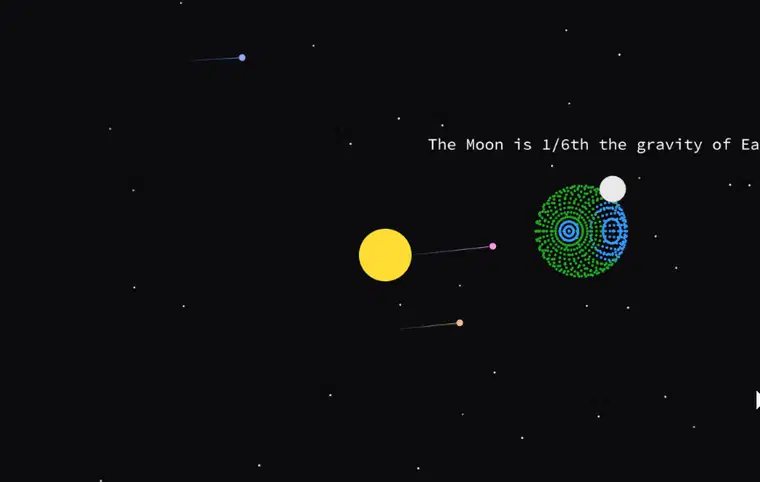p5.js is a friendly tool for learning to code and make art. And in this post we'll guide you through the steps for building your own interactive solar system simulation using ChatGPT.
Step 1: Gather your information
Before writing your prompt, you want to decide:
- Which planets will you include? (e.g. Sun, Earth, Mars, Venus, Moon)
- What are their colors, sizes, and orbits?
- Do you want extra effects like stars or trails?
For this sketch, we decided to go with the following prompt:
write a p5.sketch showing the sun in the middle and the earth orbiting the sun in a circular path. Use the sample code below that generates a rotating earth sphere with points:
let angle = 0;
let points = [];
function setup() {
createCanvas(400, 400);
colorMode(HSL);
strokeWeight(2);
// Generate points on sphere using lat/lon
let detail = 10; // lower = more points
for (let lat = -90; lat <= 90; lat += detail) {
for (let lon = -180; lon <= 180; lon += detail) {
let radLat = radians(lat);
let radLon = radians(lon);
// Convert spherical to Cartesian coords
let x = cos(radLat) * cos(radLon);
let y = cos(radLat) * sin(radLon);
let z = sin(radLat);
points.push({ x, y, z, lat, lon });
}
}
}
function draw() {
background(9);
translate(width / 2, height / 2);
strokeWeight(3);
let radius = 150;
angle += 0.01;
for (let pt of points) {
// Rotate around Y axis for globe spin
let rotatedX = pt.x * cos(angle) + pt.z * sin(angle);
let rotatedZ = -pt.x * sin(angle) + pt.z * cos(angle);
let rotatedY = pt.y;
// Perspective projection (simple)
let distance = 2;
let zOffset = rotatedZ + distance;
let px = (rotatedX / zOffset) * radius;
let py = (rotatedY / zOffset) * radius;
// Simple coloring: blue for ocean, green for land by lat/lon heuristic
// This is a very rough approximation of continents
let ocean = abs(pt.lat) > 60 || (pt.lon > -60 && pt.lon < 60 && pt.lat < 20);
if (ocean) {
stroke(210, 100, 60); // Ocean blue
} else {
stroke(120, 70, 40); // Land greenish
}
point(px, py);
}
}
Step 2: Create your Sketch
Paste the code into the p5.js Web Editor to see it in action.
Step 3: Test your Animation
Run your sketch in the p5.js web editor. Test the animation:
- Do planets orbit correctly?
- Are trails smooth?
Tweak speeds, sizes, and visuals until it feels right.
Step 4: Customize your idea
Once your solar system is working well, then try to expand on your idea to take it even further:
- Add Mars, Venus, or other planets
- Use shaders or gradients for visual effects
- Implement user controls (toggle trails, adjust orbit speed)
- Add interactive click events for comets or stars
For e.g. you can modify the sketch to include a planetary fact about the Moon is displayed (e.g. in a small tooltip or HUD text).
Github 👉 https://github.com/JavascriptDon/P5-Sketch-Examples/tree/3D-Solar-trails





Top comments (2)
pretty cool, always loved building stuff you can actually poke at and mess with - you think small changes make it more fun or it’s gotta be big features to keep it interesting?
small changes make it more fun
Some comments may only be visible to logged-in visitors. Sign in to view all comments. Some comments have been hidden by the post's author - find out more